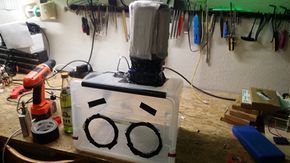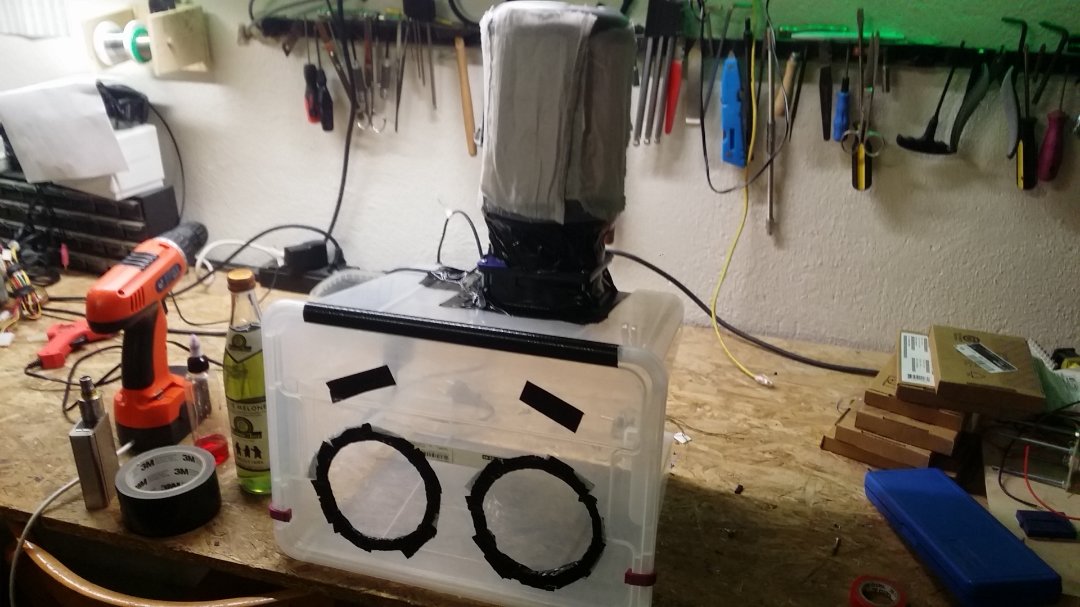Flowbox
A Flowbox (also referred to as "Laminar Flow Box") is a simple device, consisting of a box, a fan and a HEPA filter that is commonly used for activities requiring very clean and particle-less air. Some of the many application examples would include applying screen protection foil to phones and other electronics, working with high precision optics, repairing hard drives and more.
The air is generally filtered using a HEPA or even ULPA filters, often in combination with carbon, anti-bacterial or even cold-catalyst filters.
For the best results, the HEPA filter should be able to block particles, that are 3µm or smaller. To be able to work wit high-dust-sensitive items, the environment inside the flowbox should not contain more than 237,000 particles significantly smaller than 3µm per cubic meter of air.
Unlike a cleanbox that is completely sealed and has filters on both the intake and exhaust, a flowbox only needs to have a filter on the intake and ensures the cleanliness of the air inside by maintaining a positive pressure, significantly higher that the surrounding environment. This, in combination with open holes for the user's hands, ensures that the only way air can get in is through the filter(s). The hand-holes serve as exhausts for the system and don't need to be filtered, since in applications, where a flowbox is relevant, the user is not concerned about potentially dangerous stuff leaving the enclosure. If the safety of the user is potentially endangered by the activity, a fully-enclosed and filtered cleanbox should be used.
There can also be some optional extra features, such as lighing, UV lamp for sterilization, built-in fume extractor and more.
Base48 Flowbox
Our flowbox is a very simple one, built mainly for screen-protector installation, hard-drive repairs and similar activities.
Materials used:
- "SAMLA" plastic storage box from IKEA. The box is made from Polypropylene, which makes it relatively safe with most commonly used chemicals.
- Mains powered, 220V-AC fan
- Custom 3D printed plastic shroud, that connects the fan to the filter
- Custom made filter (to be replaced with a proper HEPA very soon)
Build log:
1. Cut a hole in the top of the box + four mounting holes for the fan. Rinse and repeat for additional fans.
2. Print the custom shroud that connects the fan with the filter. (Download [1])
3. Attach the fan and the shroud to the box with M4-50 bolts, some washers and locking nuts.
4. Attach the filter to the shroud.
5. Use black duct-tape to isolate any possible leakage points around the fan and to secure the filter to the fan.
6. Cut the holes for the hands and stick some tape around them to hide the sharp edges and minimise the risk of injury or glove damage.
7. Attach the lid. Our model uses a strip of tape for the top "hinge" and 3D printed clips that hold the box closed.
8. (Optional) Install LED strips for better lighting.
9. (Optional) Spray-paint the bottom of the box with heavy-duty white paint to make it more suitable for work with very small parts. This step can also aid in the identification of unwanted particles, since dust is very visible on white surfaces. Glossy paint is recommended, as matte finishes are more susceptible to damage and smudges created by abrading softer surfaces, such as plastic.)
(Our temporary filter is made from an old dietary-supplement bottle and some cloth, secured in place with hot-glue and duct-tape. A proper HEPA filter in on the way.)
(Using a box made of a different material would be favourable, since polypropylene is naturally somewhat cloudy and does not provide the optimal clarity for precision work inside the box.)
(More photos coming soon!)

